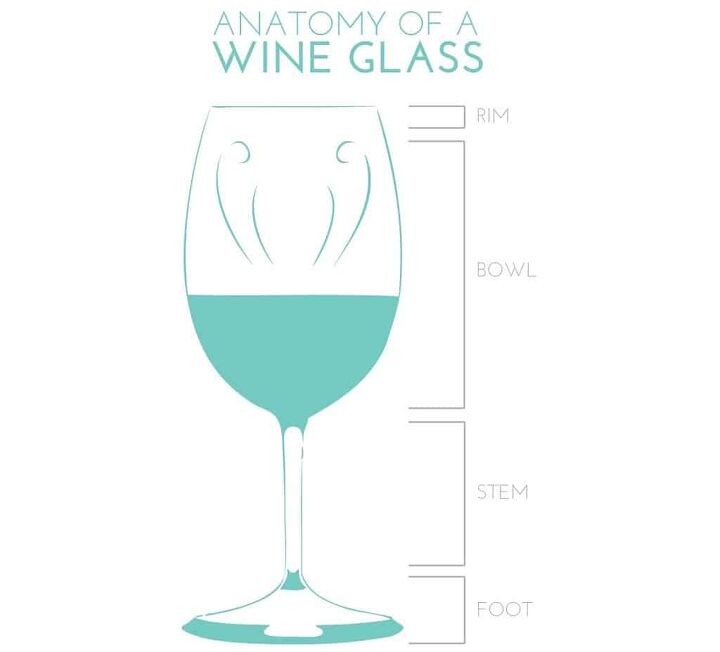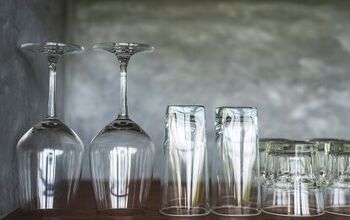11 Different Types of Wine Glasses (And Their Uses)

You can drink wine from whatever container you desire, whether it be a wine glass, mason jar, coffee mug, plastic cup, or just straight out of the bottle (no judgment here). However, using the right type of glass will actually enhance the taste of the wine you are drinking. Wine glasses are specifically designed to bring out your wine’s character and nuances.
If you’ve ever taken a look at the selection of wine glasses at your local home décor store, you know that there are many options to choose from. From big and small, to goblets, flutes, and tulips; the different types of wine glasses can be very confusing. Not to mention, how the heck do you know which wine is supposed to go in which glass?
In this article, we’ll explore all the various types of wine glasses, which type of wine goes in each, the anatomy of a wine glass, and the importance of using the proper vessel.
The Importance of the Proper Wine Glass
One of the major components to enjoying a glass of wine has to do with savoring the aroma. The goal of your glass is to gather the wine’s aroma properly, allowing you to relish in it. If you were to simply use just a large mug filled to the top, all of the distinguishing vapors from the wine will have been released before you even took your first sip.
In fact, there is now scientific evidence that supports the importance of using the proper type of glass. In 2015, a medical group based in Japan used a special camera to document images of ethanol vapors in various glasses. Their study revealed how different glass shapes impacted the position and density of the vapors at the glass openings.
The reason why vapors matter so much is that they are what carry aromatic compounds to your nose. These aromatic compounds are responsible for producing the large majority of the flavors found in wine.
The Anatomy of a Wine Glass
While there are many different wine glasses to choose from, the basic shape is roughly the same. The shape of a wine glass is meant to not only collect the aroma from the wine, it also controls how much wine flows into your mouth. More specifically, it regulates whether the wine spreads to the side of your mouth or moves over your tongue.
The parts of a wine glass can be broken down into four different pieces: the rim, the bowl, the stem, and the foot.
- Rim: The rim is the topmost part of a wine glass and the area that your mouth touches when drinking. How thin the rim is can impact how you perceive the taste of the wine. Generally speaking, a glass with a thin rim is much better than a thick rim glass. A thinner rim allows for the wine to flow smoothly into your mouth, without being slowed by a thick edge.
- Bowl: The bowl is where the wine rests in the glass. This is the part of a wine glass where you’ll see the most variation among types. However, in most cases, the opening of the bowl will generally be smaller than the shoulder (or, the widest part of the bowl). The bowl is designed this way to capture the aroma of the wine. The width of the bowl is what controls the surface area of wine. Some wines, such as aged reds, must breathe more than others, meaning they’ll require a larger bowl to capture their more intense aromas.
- Stem: The stem refers to the thin, neck area where you generally hold the wine glass from. By holding the glass by the stem, you prevent your hands from warming up the wine. It’ll also keep the bowl from getting smudged by your fingerprints.
- Foot: The foot, or base, is the flat section of the glass that holds it upright when placed on a level surface. When a glass has a small foot, it will be imbalanced and the stemware can easily topple over. Whereas, too large of a base and it might get stuck under your tableware, flatware, or platters.
Now that we have a better understanding of the importance of the right glass and the anatomy of a wine glass, let’s dive into the various types.
Types of Red Wine Glasses
Choosing a red wine glass has a lot to do with alleviating the bitterness of tannin or spicy flavors in the wine to deliver a smoother taste. Tannins are naturally occurring polyphenols found in seeds, bark, leaves, wood, plants, and even the skin of fruits. Most commonly found in red wine, tannin is generally caused by the fermenting of skins or from aging in wooden barrels. It adds complexity, astringency, and bitterness to your wine.
In general, you’ll find that tasting a red wine from a glass that has a wider opening yields a much smoother taste. Of course, the fact that there is a larger distance from your nose to the liquid will impact the aroma – hence, influencing the taste. With that said, let’s examine the six different types of red wine glasses.
1. Cabernet
Cabernet wine glasses are one of the largest types of glass for use with red wine. The glass is designed to intensify the aroma of the wine, focusing it, magnifying it, and delivering it to your nose. Since the bowl of the glass is large, the red wine can breathe appropriately. Whereas, the narrow mouth traps in the aroma and the thin rim delivers the liquid smoothly into your mouth.
Though it may be tempting to give yourself a heavy pour, it’s important that you don’t overfull a cabernet wine glass. It’s not uncommon to think that since it’s such a large glass, more wine can be poured into it. However, for best results, it’s always recommended to pour smaller amounts into the glass. This will enhance the smell, taste, and overall enjoyment of the wine.
2. Burgundy
The next on our list of red wine glasses is the burgundy glass. Compared to cabernet, the bowl of a burgundy glass is much larger. The size of the bowl is meant to accommodate the aromas of red wines that tend to be slightly more delicate. Because of the shape of the bowl and rim, you’ll first taste the wine on the tip of your tongue, then it’ll travel throughout your mouth.
By tasting wine on the tip of your tongue, you are able to fully experience both the taste and smell of even the subtlest of wines. That way, you don’t miss any of the specific nuances. The length of the stems on burgundy glasses can vary slightly, with a shorter stem reducing the risk of it toppling over.
The rim of these glasses is generally very thin. As previously mentioned, this allows the wine to be smoothly delivered into your mouth, makes it easier to drink, and keeps the liquid at the front of your mouth.
3. Bordeaux
Of all the types of red wine glasses, Bordeaux glasses tend to be the tallest. However, their bowl is generally much smaller than the alternatives. They are the best choice for bolder, full-bodied red wines such as Merlot or Cabernet.
Since the glass is so tall, it delivers more aromatic compounds versus the burn of ethanol from being a farther distance from your nose. The larger surface area allows for more room for the ethanol to properly evaporate. Whereas, a wider opening makes the wine remain at the tip of your tongue and taste much smoother.
With this glass, you’ll be able to achieve the best possible drinking experience out of those wines with more full, rich flavors. It ensures that you are able to fully enjoy all of the little nuances, without the wine being too bitter to drink.
4. Zinfandel
The perfect wine glass for Zinfandel is, you guessed it, the Zinfandel wine glass. It is slightly shorter than the Bordeaux and has a slightly larger rim. They are often considered the standard red wine glass, and likely what you already have in your home. This is a great glass for red wines that are medium to full-bodied and contain spicy notes and/or a high alcohol content.
With the smaller opening, the spice flavors are softened due to the fact that the flavors reach your tongue more gradually. Although the bowl is smaller than some of the other options, it is still large enough to allow the red wine to breathe properly.
Aside from Zinfandel, this glass is also great for Petite Sirah, Syrah (Shiraz), and Malbec wines. While you could certainly use a Bordeaux glass for either of these wines, you will enjoy the wine much more and have the best overall tasting experience.
5. Pinot Noir
Pinot Noir glasses are stunning and have the widest bowl of all the other types of wine glasses. This allows for the wine to have the most contact with air as possible, improving both the flavor and aroma. With a large bowl, you can easily swirl your wine to incorporate more air and enhance the wine further.
The stems on these glasses are slightly shorter than others and the easiest way to discern them is to look at the rim. On a pinot noir glass, the rim is slightly turned out. This helps to direct the flavor and aroma of the wine directly to your mouth and nose.
The best wine to use for this glass is, you guessed it again, Pinot Noir. When drinking this type of wine, you want to capture the intensity and the best way to achieve this is by using the right kind of wine glass.
6. Rose
The final type of red wine glass is the rose glass, which has a long stem and resemble a rose – hence the name. There are two main types of rose glasses you’ll find: ones with a short bowl and a short taper and other with a short bowl and a flared-out rim. Either one is great for enjoying a rosé out of, but the flared rim is generally preferred when drinking a younger wine.
With a younger rosé, the flavor tends to be less sweet than other aged wines. The flared rim helps to direct the wine to your taste buds that are more sensitive to sweetness. This will maximize the flavor of the wine and minimize the likelihood of unpleasant aftertastes.
Types of White Wine Glasses
As opposed to red wine, white wine is generally served in glasses with significantly smaller bowls. Opting for a smaller glass with white wine helps to deliver more aromas, maintain a cooler temperature, preserve floral notes, and express more acidity in the wine.
However, you’ll notice that white wines that are more full-bodied such as White Rioja, orange wines, Viognier, and oak-aged Chardonnay are best enjoyed in a larger bowl. With that said, let’s take a look at the five different types of white wine glasses.
1. Chardonnay
Generally speaking, and as you will see moving forward, wine glasses that are meant for the white variety tend to have more of an upright, u-shaped bowl. Such is the case with the Chardonnay glass. While it is somewhat similar in shape to the aforementioned Pinot Noir glass, the bowl is slightly smaller.
Since the opening is large, larger than other types of white wine glasses, this glass is the ideal choice for younger white wines. The large opening helps to direct the wine to the tip of your tongue and the sides of your mouth, as opposed to the back of your mouth. This allows you to fully enjoy the wines’ sweetness.
2. Viognier
The Viognier wine glass has a smaller bowl and rim than the Chardonnay glass. It’s important that the bowl is small enough to limit the contact of air with the wine. Too much oxygen will quickly destroy the aromatic compounds that contribute to the flavor of the wine.
Viognier wine has aromatics that are generally associated with pears, peaches, and violets. It’s vital that the wine glass you drink it out of is designed to protect all of these lovely aromas. These types of wine are usually drunk when they are younger, meaning they’ll be slightly sweeter. The shape of the glass allows you to have the best possible drinking experience.
As an added bonus, the Viognier glass’ low center of gravity prevents it from easily being knocked over, should an accident occur.
3. Sparkling
Sparkling glasses, or sometimes simply called champagne glasses, are perfectly upright and the narrowest of all the types of white wine glasses. The design of this glass helps to preserve the carbonation of the wine and will enhance the tasting experience. It’s very important that you drink champagne or other sparkling wines out of these types of glasses, as alternatives with wider bowls will quickly cause the wine to go flat.
Both the shape of the glass and the small opening will cause the liquid to hit your tongue immediately and the aromas to flow upward to your nose. These flutes can often be found gorgeously decorated and are the perfect choice for special celebrations. If you regularly entertain guests, it’s strongly recommended that you have a set of sparkling glasses among your collection.
4. Sweet Wine
As the name suggests, these types of wine glasses are meant for sweeter, dessert wines. Sweet wine glasses are smaller overall and have a smaller rim than others on this list. This shape is ideal for delivering the wine to the back of your mouth, ensuring that the sweetness isn’t too overwhelming to be properly enjoyed.
The size of the bowl and the tapered rim allows you to swirl the wine, which can enhance the acidic content, help to combat the level of sweetness, and create a perfect balance between the liquid and the surrounding air. Since dessert wines tend to have a much higher alcohol content than other white wines, they are best enjoyed in these smaller glasses.
5. Vintage
Vintage wine glasses are very elegant and are reminiscent of the 1920s (think, Leonardo DiCaprio in The Great Gatsby). However, they aren’t always the best glass to drink out of as they are not designed to specifically enhance the aroma and flavor of the wine. These glasses are often a hit or miss, making only some types of wine taste better than others.
With that said, they are still very popular due to the fact that they have a gorgeous shape and are very comfortable to hold. From plain glass to ornate, cut crystal, Vintage wine glasses come in a number of designs and styles. They can be as fancy or as refined as you desire.
The major issue with these types of glasses is that the bowl and rim is so wide that it can be tricky to enjoy a glass without spillage. However, if you want your wine to have maximum contact with oxygen, vintage wine glasses are the way to go. In fact, as previously mentioned, more full-bodied wines are best enjoyed in glasses with a wider bowl.
Additional Types of Wine Glasses
While the above are the most prevalent types of wine glasses for red and white wine, there are other options. One example that has gained popularity recently is stemless wine glasses. They are, as the name indicates, a wine glass without a stem. Though they are popular, they aren’t necessarily recommended since the way you hold them will heat up the wine.
Other additional types of wine glasses include “flutes,” which appear like sparkling glasses but are taller and skinnier, balloon glasses, sherry glasses, and those fun “glasses” that you can pop onto the top of a wine glass and drink right out of the bottle. Those are my favorite!
What is a “Standard Pour” of Wine?
Whether you are an avid wine drinker or not, you’re likely somewhat aware of the “standard pour.” Although this concept doesn’t actually exist legally, the general rule of thumb is that a pour is somewhere around the 5-ounce mark. You may be wondering what the reasoning behind 5-ounces when a standard glass of water is usually 8-ounces.
The standard pour takes care of two birds with one stone: it limits the amount of alcohol you consume, which allows you to fully appreciate the wine, while also allowing your host to get five glasses out of a bottle of wine.
Therefore, in restaurants, you can expect the standard pour to be roughly five ounces. Whereas, the standard for wine tastings is around two ounces. This is sufficient enough liquid to allow you to experience both the flavor and aroma of the wine, without being too quickly affected by the alcohol it contains. Additionally, some dessert wine servings tend to be two ounces, as these are much sweeter and have more alcohol.

Jessica considers herself a home improvement and design enthusiast. She grew up surrounded by constant home improvement projects and owes most of what she knows to helping her dad renovate her childhood home. Being a Los Angeles resident, Jessica spends a lot of her time looking for her next DIY project and sharing her love for home design.
More by Jessica Stone



















![10 Best Electric Lawn Mowers - [2022 Reviews & Top Rated Models]](https://cdn-fastly.upgradedhome.com/media/2023/07/31/9070486/10-best-electric-lawn-mowers-2022-reviews-top-rated-models.jpg?size=350x220)






![Standard Dining Room Table Dimensions [for 4, 6, 8, 10 and 12 People]](https://cdn-fastly.upgradedhome.com/media/2023/07/31/9074335/standard-dining-room-table-dimensions-for-4-6-8-10-and-12-people.jpg?size=350x220)





